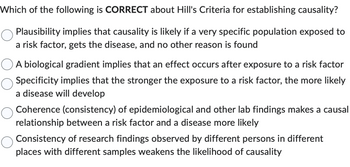
Concept explainers
1

The Bradford Hill criteria, sometimes known as Hill's criteria for causation, are a set of nine guidelines that have been extensively utilized in public health research. They can be helpful in producing epidemiologic evidence of a causal relationship between a hypothesized cause and an observed effect. The English epidemiologist Sir Austin Bradford Hill founded them in 1965.
The following is a list of the criteria:
1. Strength (effect size): Although a big connection increases the likelihood that it is causal, a modest association does not rule out the possibility of a causal influence.
2. Consistency (reproducibility): Findings that are consistent across several observers, locations, and samples increase the likelihood that an effect is occurring.
3. Specificity: If a disease is present in a specific location in a highly specific population, and there is no other plausible explanation, causality is likely. The likelihood of a causal relationship increases with the degree of specificity in the association between a factor and an effect.
4. Temporality: The result must follow the cause (and if there is an expected delay between the cause and expected effect, then the effect must occur after that delay).
5. A biological gradient (dose-response relationship) states that an effect should typically occur more frequently with higher exposure levels. However, in other circumstances, the effect can be triggered by the factor's simple existence. In some instances, an inverse relationship is seen: higher exposure causes a decrease in occurrence.
6. Plausibility: It's beneficial to have a believable cause-and-effect system (but Hill noted that knowledge of the mechanism is limited by current knowledge).
7. Coherence: The likelihood of an effect is increased when epidemiological and laboratory findings are consistent. Hill did point out that "the epidemiological effect on connections cannot be nullified" by the absence of such [laboratory] proof.
8. Experiment: "Experimental evidence may occasionally be cited as support."
9. Use of comparisons or analogies; between the relationship under study and any other relationships.
Step by stepSolved in 2 steps

 Human Anatomy & Physiology (11th Edition)BiologyISBN:9780134580999Author:Elaine N. Marieb, Katja N. HoehnPublisher:PEARSON
Human Anatomy & Physiology (11th Edition)BiologyISBN:9780134580999Author:Elaine N. Marieb, Katja N. HoehnPublisher:PEARSON Biology 2eBiologyISBN:9781947172517Author:Matthew Douglas, Jung Choi, Mary Ann ClarkPublisher:OpenStax
Biology 2eBiologyISBN:9781947172517Author:Matthew Douglas, Jung Choi, Mary Ann ClarkPublisher:OpenStax Anatomy & PhysiologyBiologyISBN:9781259398629Author:McKinley, Michael P., O'loughlin, Valerie Dean, Bidle, Theresa StouterPublisher:Mcgraw Hill Education,
Anatomy & PhysiologyBiologyISBN:9781259398629Author:McKinley, Michael P., O'loughlin, Valerie Dean, Bidle, Theresa StouterPublisher:Mcgraw Hill Education, Molecular Biology of the Cell (Sixth Edition)BiologyISBN:9780815344322Author:Bruce Alberts, Alexander D. Johnson, Julian Lewis, David Morgan, Martin Raff, Keith Roberts, Peter WalterPublisher:W. W. Norton & Company
Molecular Biology of the Cell (Sixth Edition)BiologyISBN:9780815344322Author:Bruce Alberts, Alexander D. Johnson, Julian Lewis, David Morgan, Martin Raff, Keith Roberts, Peter WalterPublisher:W. W. Norton & Company Laboratory Manual For Human Anatomy & PhysiologyBiologyISBN:9781260159363Author:Martin, Terry R., Prentice-craver, CynthiaPublisher:McGraw-Hill Publishing Co.
Laboratory Manual For Human Anatomy & PhysiologyBiologyISBN:9781260159363Author:Martin, Terry R., Prentice-craver, CynthiaPublisher:McGraw-Hill Publishing Co. Inquiry Into Life (16th Edition)BiologyISBN:9781260231700Author:Sylvia S. Mader, Michael WindelspechtPublisher:McGraw Hill Education
Inquiry Into Life (16th Edition)BiologyISBN:9781260231700Author:Sylvia S. Mader, Michael WindelspechtPublisher:McGraw Hill Education





